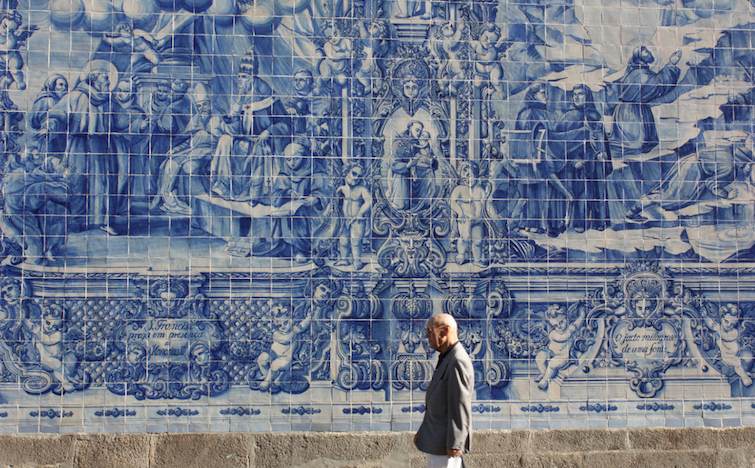The Azulejo Tiles of Portugal
25 October, 2016
When you first visit Portugal, one of the things that invariably catches your eye is the pervasive presence of ceramics and wall tiles in ornamentation. Whether used as wall facings on the inside and outside of buildings – on churches, palaces or private homes, both in large cities and small villages – ceramic tiles are king in Portuguese decoration. Unlike the rest of Europe, where they are used more sparingly, in Portugal they seem to take over the walls. They feature in two major varieties – polychromed tiling and the signature blue-and-white combination, some of which are technically and aesthetically superb.
This cultural heritage of Moorish origin first took seed in Portugal in the 15th century, having entered the country via neighbouring Spain. It soon became the wall facing of choice among Portuguese royalty. The use and quality of ceramic tile decoration reached their zenith in the 18th century. Nowadays, azulejos are still very much in vogue and large workshops continue to operate.
While ceramics are in evidence throughout the country, following is a selection of the leading sites. They are well worth visiting – both for the exquisiteness of their ornamentation or owing to the presence of a large production centre.
Lisbon
As befits a capital, Lisbon is graced with numerous examples of azulejo tile facings, which even cover the walls of the city’s metro system. Among some unusual landmarks to be found in the city is the Quinta dos Azulejos, housed in the Colégio Manuel Bernardes on Paço do Lumiar street. The sheer decorative beauty of the scenes depicted on the walls in the garden is simply stunning.
However, the main reason for including Lisbon in this tour is the Museu Nacional do Azulejo, where visitors can learn all the ins and outs, production techniques and history of this quintessentially Portuguese element of architectural ornamentation. It is also a good point to start off the tour.
Aveiro
This small, beautiful city, also called the “Venice of Portugal” for its canals, which you can sail along in colourful boats known as moliceiros, is enchanting in itself. A coastal city famed for its fishing and salt production, it has a beautiful centre with outstanding examples of Modernist buildings. The authentic jewel of this city is the Railway Station, striking for its ceramic ornamentation and a fitting final flourish to any visit here. The polychromed azulejos feature depictions of railway scenes, as well as motifs from nature, culture and traditional activities. And, while you are in the city, be sure to see the beach with its bathing boxes painted in colourful stripes.
Ovar
This coastal city is worth visiting for its beaches, but it also boasts a large number of public buildings adorned with azulejos, most of which come from the factories at Vila Nova de Gaia and Aveiro. The plethora of tiled wall facings has earned Ovar the nickname of the “Azulejo Museum City”.
Válega
Just six kilometres from Ovar lies the village of Válega, where you should make a point of visiting the Church of Nossa Senhora do Amparo. Its walls are faced, both inside and out, with mostly polychromed tiles, except for the external side walls and back, which are bicoloured in blue-and-white tiles. Construction work on the church began in 1746 and lasted for a whole century.
Ilhavo
Ilhavois noteworthy above all for its Vista Alegre Factory, one of the most internationally acclaimed sites in Portugal. Founded by José Ferreira Pinto Basto in the early 19th century for glass and porcelain production, it houses a museum where visitors can learn about ceramics culture through the collections on display and the values associated with Vista Alegre.
Book your Vueling to Lisbon and discover for yourself this wonderful ceramic ornamentation on Portuguese buildings and monuments.
Text by Los Viajes de ISABELYLUIS
Images by Sunny Ripert
25 October, 2016







